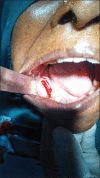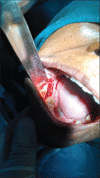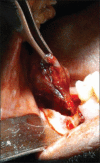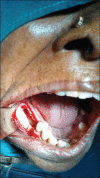Trigeminal neuralgia induced by odontogenic keratocyst associated with impacted supernumerary teeth: A rare case report
- PMID: 29491624
- PMCID: PMC5824508
- DOI: 10.4103/jomfp.JOMFP_280_17
Trigeminal neuralgia induced by odontogenic keratocyst associated with impacted supernumerary teeth: A rare case report
Abstract
Odontogenic keratocyst(OKC)is a cyst oftooth origin with an aggressive behavior including a high recurrence rate, it has been rechristened to keratocystic odontogenic tumor(KCOT) as it be the reflects its neoplastic nature. We report a case of KCOT in association with an impacted supernumerary tooth along with Trigeminal Neuralgia, that subsided by itself after removal of the cyst.
Keywords: Odontogenic Keratocyst; Supernumerary tooth; Trigeminal Neuralgia.
Conflict of interest statement
There are no conflicts of interest.
Figures















References
-
- Rapini RP, Bolognia JL, Jorizzo JL. Dermatology. 1, 2. St. Louis: Mosby; 2007. p. 101.
-
- Joffroy A, Levivier M, Massager N. Trigeminal neuralgia – Pathophysiology and treatment. Acta Neurol (Belg) 2001;101:20–5. - PubMed
-
- Scrivani SJ, Mathews ES, Maciewicz RJ. Trigeminal neuralgia. Oral Surg Oral Med Oral Pathol Oral Radiol Endod. 2005;100:527–38. - PubMed
-
- Adams CB. Trigeminal neuralgia: Pathogenesis and treatment. Br J Neurosurg. 1997;11:493–5. - PubMed
-
- Love S, Coakham HB. Trigeminal neuralgia: Pathology and pathogenesis. Brain. 2001;124:2347–60. - PubMed
Publication types
LinkOut - more resources
Full Text Sources
Other Literature Sources

